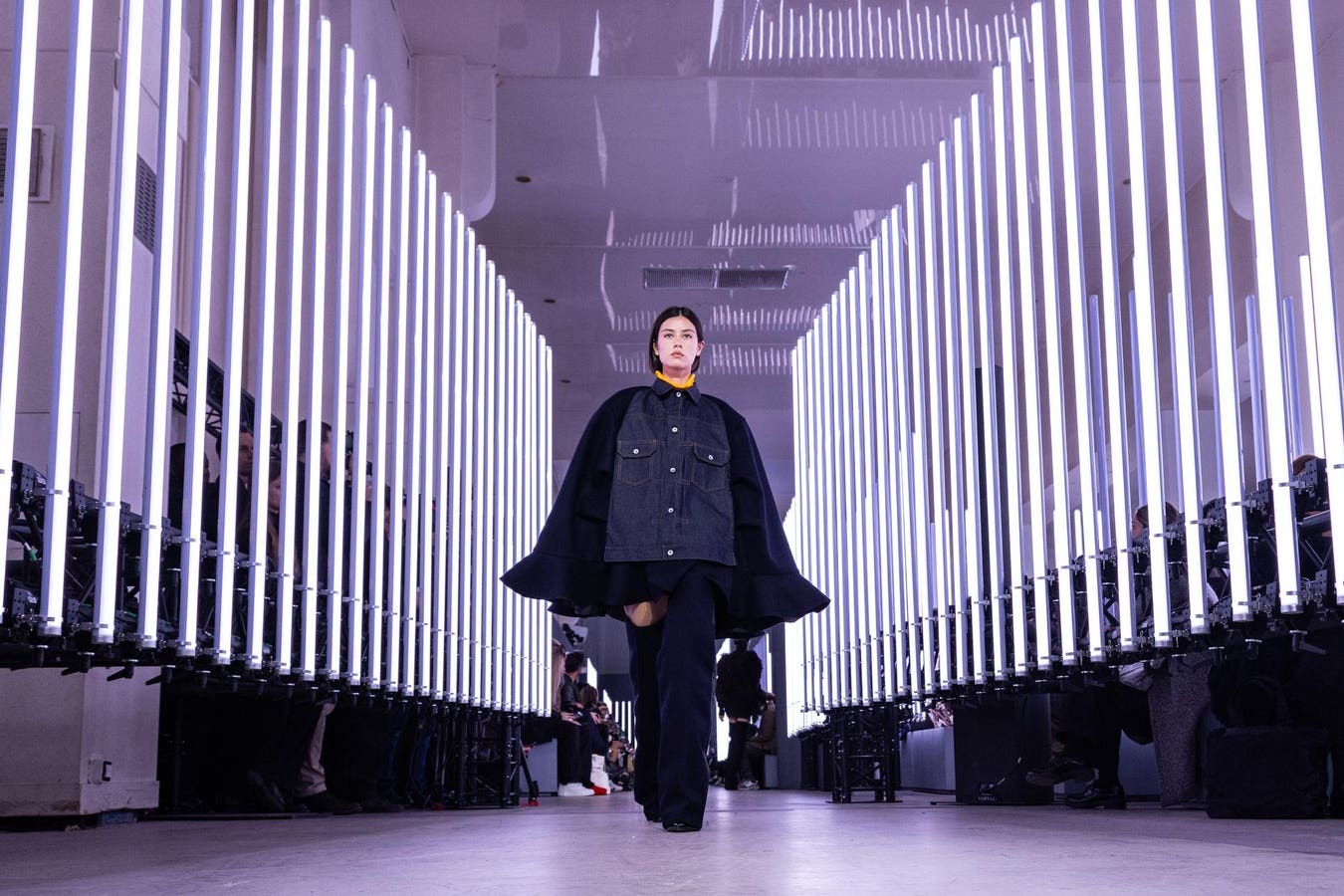While mix-matching and mashing up hybrid clothing is popular among the Japanese design school, no one is more synonymous with it than Chitose Abe of Sacai. She created her brand by reimagining iconic wardrobe staples-the nylon bomber, the peacoat, the fisherman knit sweater, a white shirt, a kilt skirt, and fleece items, for example—and spliced them up nine ways to Sunday, combining multiple garments into one magical piece that usually defies pattern making and other construction mechanics.
While her brand relied on word of mouth for many years as its power grew, thanks to fashion’s curtain being pulled back, Sacai has become a cult status brand, with its fans spanning several generations. The Autumn Winter 2024 show, held at an open space near the Invalides in Paris, was bathed in tubes upon tubes of green neon light lining a complex maze-like runway that made several twists and turns, a fitting analogy to her clothing construction.
Abe took those familiar codes once and again but turned them on their heels with volume and shape for a stunning collection that the Japanese designer said was rooted in protection.
In a post-show release, Abe explained that her jumping-off point was the late photographer and fashion historian Bill Cunningham, a legend as the true inventor of street style. A statement of his inspired her, “Fashion is the armor to survive the reality of everyday life.”
In this sense, the designer suggests that fashion can buy a sense of peace and safety (no argument here) in today’s complex and conflict-ridden world. Abe considered what constitutes a dress and added volume and ruffled pleating to outerwear and chunky knits that appeared more as a frock than their intended use and addressed today’s ‘can’t be too bothered to look fabulous but need to’ and connected underpinnings and shirts to outerwear. Upper-thing grazing boots appear as pants when seen straight on.
Just when you’d seen all of Abe’s hybrid tricks, especially on bomber jackets and pea coats, the designer fashioned blue shirt front, navy peacoat sleeves, and a brown bomber back side that billowed like a 1960s couture gown. A set of double-breasted peacoats had every editor and buyer making a note for their personal shopping. From any vantage point, a Sacai piece is equal parts fierce and many parts gorgeous.
Another Japanese designer known to have his acumen around garment splicing is Jun Takahashi, whose Undercover show was one of the best yet and delivered the elusive, intellectual, and high-brow design but loaded with commercial appeal (To wit, Saks, Neiman Marcus, Bergdorf Goodman, and Nordstrom
JWN
Instead of a soundtrack, the designer plucked Christopher Walken to recite a narrative to explain who this season’s Undercover woman is. In this case, she’s 40, a single mom of a school-age boy, works at a law firm, and keeps a routine and low profile. However, lacking any apparent day-to-day joy, her reimagined wardrobe expresses both creative and pragmatic taste.
High-concept coveralls resembling a camisole and jeans opened the show as the Undercover woman donned a camel cardigan that appeared to be layered over a tailored shirt. The looks that followed also suggested a no-muss, no-fuss approach to looking sharp.
The show was a hit and put the brand on many top ten collections of the season lists.
Another designer known more for upcycling than splicing made her return to the runway for Fall Winter 2024, Marine Serre. The LVMH-Prize winner has made an IYKYK status brand with her crescent-shaped moon logo, though she had skipped the last season.
For this effort, Serre chose Ground Control, a food and retail hall in the 12eme, which features interior airplane sections as décor. In perhaps a diplomatic approach, Serre demonstrated that her logo pattern could be on everything from her signature brand slinky knits to shopping bags, carts, and food packaging. Her eclectic cast of models suggested that anyone—female, male from infancy through mature age—can don Serre. The varied cast of models played to the audience with an occasional glance or nod as they paraded as if walking through daily life.
The ubiquitous patterns everywhere didn’t mask the lack of solid design direction once associated with the budding brand. Instead, Serre played it safe by driving home her distinct logo, which is not bad in today’s retail climate.
Read the full article here





